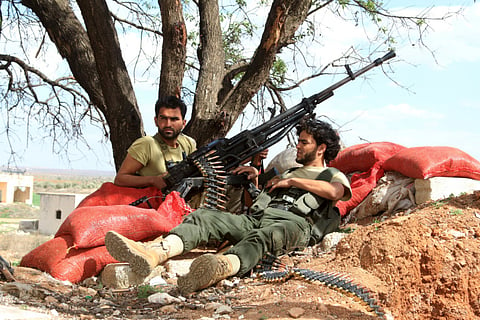Guns, not handshakes, shaped Syria’s war
Four military game-changers sometimes spelt doom for peace, but gave it new life at other times

Beirut: It was blood, guns and bullets rather than statesmanship and handshakes that changed the course of the Syrian war.
There were four game-changers in the conflict, which amidst a ghastly death toll of 270,000 commemorates five years of war today. All were military developments that had a major effect on the ever-fragile political process, sending it sometimes to the grave and at other times breathing new life into it.
Yet, for the first time in five years a shaky ceasefire is now holding. This is probably the most serious effort to end this war since its outbreak in March 2011.
Collective assassination
The first game-changer was the collective assassination of four top Syrian generals at a security complex in Damascus in July 2012.
This operation — claimed by Islamists and the Free Syrian Army (FSA) — led to the elimination of two defence ministers, an intelligence chief, and the deputy chief-of-staff of the Syrian Army, who happened to be the brother-in-law of President Bashar Al Assad.
It was the first operation of its kind in central Damascus, 14 months after the outbreak of hostilities in early 2011. The rebels expected the regime to collapse from within.
They advanced on the Syrian capital that evening from the orchards of Mezzeh and Al Ghouta in the Damascus countryside, bringing battles to the heart of the city.
Focused on preventing a sudden collapse in Damascus at any cost, the Syrian Government rushed reinforcements to the city, setting up checkpoints at every street corner, sending tanks to the suburbs, and then bombarding them almost daily.
Since then Syrian rebels have responded with 10-60 mortars, almost daily, striking at residential districts of the Syrian capital. As a result of the assassination operation of July 2012, a mass concentration of troops was brought to the capital, leaving entire parts of the Syrian north — including Aleppo — unchecked.
Within one year, most of Aleppo, its entire countryside, all of Raqqa, most of Deir Al Zor, and the suburbs of Hama, Latakia, and Idlib all fell to the Saudi- and Turkish-backed opposition. The trend only stopped when the Russian Air Force entered the war in September 2015. July 2012 saved Damascus but destroyed most of Syria.
The first game-changer killed any real appetite for a ceasefire or negotiated settlement to the Syrian crisis.
UN mediator Kofi Anan tried to enforce a truce in October 2012 but it collapsed within hours; the Syrians only came to the negotiating table in January 2014, but that effort too ended in vain.
For two years both camps pledged that they would settle for nothing less than control of the entire country, with the seat of power in Damascus.
Chemical weapons deal
That momentum fizzled after the second game-changer, being the chemical weapons deal hammered out between US Secretary of State John Kerry and his Russian counterpart Sergei Lavrov in September 2013.
Obama secured a deal that enraged the Syrian opposition, giving the Syrian regime de facto recognition from the international community, via direct talks with the 192-member state Organisation for the Prohibition of Chemical Weapons (OPCW).
Officials from Damascus were back on the airwaves, peddling their official version of events, and sitting across negotiating tables with UN officials and international statesmen. This ended the boycott of Damascus that started with the evacuation of foreign embassies in the summer of 2011.
Obama began to softly change his policy of regime change, hinting that Al Assad can be part of the transition.
Rise of Daesh
The third game-changer no doubt was the rise of Daesh in the summer of 2014.
In June and July, Daesh swept into Mosul and other cities along the Syria-Iraq border. Daesh swiftly took Fallujah, west of Baghdad, and overran Raqqa. In May 2015, Daesh took the ancient city of Palmyra and most of Deir Al Zor.
The fall of Raqqa and Palmyra killed whatever momentum was left in the international community to bring down Al Assad’s regime. Some even started hinting that only the Syrian army had the manpower and will to fight Daesh.
The summer of 2014 was a turning point for Syrian officialdom and the West, transforming it from a “revolt” — as the opposition insisted — into a war on terrorism.
Russian intervention
The fourth and most recent game-changer was the start of Russian operations in September 2015, exactly one year after US started bombing.
Russian involvement in the ‘war on terror’ transformed government troops from the defensive, where they had been waging a uphill battle since 2012, to the offensive.
Turkish proxies now control one village only on the Syrian-Turkish border — Azaz — whereas two years ago they commanded everything and everybody along that border.
Syria has been a graveyard for political and military analysis since 2011. Five years down the line, only negotiatiations is on the table for Syria.
The momentum is there and so is the will, as international players are more focused on combating Daesh than toppling Al Assad.
Sign up for the Daily Briefing
Get the latest news and updates straight to your inbox



